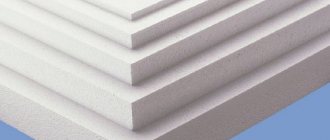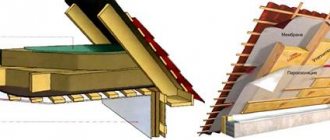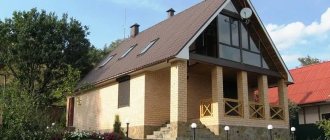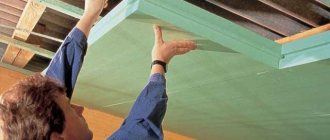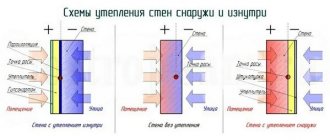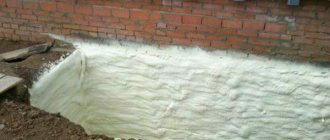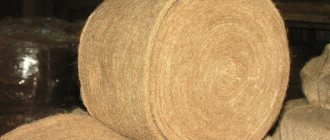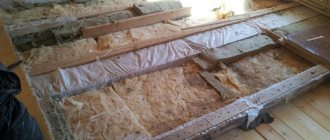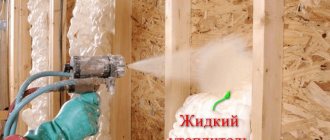- From timber
When setting up a steam room, it is very important to take care of the quality of its thermal insulation. Therefore, today we will tell you how to insulate walls in a bathhouse from the inside. Let's consider what materials to choose depending on the nature of the structure, what technology is used to lay them and the rules followed. Let us immediately note that it is ineffective to carry out such work outside the building, no matter what it is made of, timber, concrete or brick.
Advantages of internal insulation
- Reduces fuel consumption (either solid fuel, such as wood or coal, or gas) and reduces heating time.
- It is the key to the desired microclimate in the steam room. You will forget about drafts, dampness, cold, and you will be able to feel comfortable in any season.
- Ensures proper circulation of hot air, preventing condensed moisture from settling on various surfaces of the rooms. Thanks to this, the cladding remains dry, resists mold and fungi, does not rot, does not deteriorate longer and looks beautiful in a new way.
Practical advice
Experienced craftsmen have formulated several tips for those who decide to insulate a steam room with their own hands:
- Window design. To reduce heat loss from windows, it is better to make them small and carefully insulate the opening and slopes. In addition, they need to be placed lower so that the hottest air does not touch them. At the same time, condensation on the glass will be reduced. Multi-chamber metal-plastic windows should be installed to reduce heat loss through the frame.
- The doorway should be low, with a high threshold. This will reduce the outflow of warm air through the upper part and the influx of cold air through the lower part of the opening.
- You should select the furnace power corresponding to the area of the steam room. It is also important to place a sufficient amount of stones in the heater. To speed up heating and increase heat transfer, stones are placed in special wire mesh around the chimney or firebox body.
A properly insulated steam room warms up quickly and retains heat for a long time. It is cozy and comfortable, fuel is consumed economically. If a home craftsman has the skills of general construction work and follows the recommendations given, he can easily insulate the steam room with his own hands.
Which insulation is better depending on the type of building
When choosing insulation for the walls of a bathhouse, it is important to consider what material it is built from.
From timber
In the case of a durable type of wood and a relatively large cross-section of each element of the frame, it is enough to simply caulk the cracks and treat the walls with impregnations against fungus and mold, as well as compounds that protect against moisture and fire.
In other situations, all rooms (especially the steam room) must be insulated with basalt wool - in one layer, using the “Pie” technology (we will consider it separately below), additionally laying foil material to minimize the harmful effects of steam.
Made of brick
It freezes quickly in the cold season. This means that measures need to be taken to ensure that a suitable microclimate inside is maintained even in the harshest winter. To do this you can:
- install second walls around the entire perimeter;
- or make a double thermal insulation layer.
To create the sheathing, it is better to use wood rather than metal, since the latter gets very hot during operation. Naturally, it is recommended to treat the prepared structure with agents against fire, rotting, and insects.
Made from concrete
In this case, you can insulate the walls in the steam room of the bathhouse from the inside and outside. Such a serious approach will result in the absence of problems with the masonry getting wet (due to condensed steam), and will become a measure that effectively prevents rapid destruction.
Here the craftsman upholsters the surfaces in the room with 10 cm thick mineral wool (or an analogue suitable in structure), and from the street he arranges a hinged ventilated facade, that is, he fixes the same basalt sheets and covers them with clapboard or siding. The method is relatively expensive, but it guarantees the correct microclimate.
Made from expanded clay concrete blocks
Here you will also need moisture-resistant material, but in combination with high-quality hydro- and vapor barrier. Plus, it is worth installing additional ventilation - this will help level out the increased level of humidity. It is quite acceptable to lay foil tape in as thin a layer as possible.
Selecting a skin
Is it possible to cover a steam room with plastic rather than wood? Yes. But steaming will not be comfortable. Not even any type of wood is suitable for such premises. Preference is given to linden, alder, aspen and abash. When heated, such wood maintains a temperature close to 36 degrees, does not darken, and does not burn human skin. After steam treatment, a pleasant smell specific to each tree is released. The choice of wood depends only on the taste of a particular person.
Lining with foil in the steam room
Article on the topic - penofol insulation.
To preserve the characteristic properties of the finish, each element is necessary in advance:
- Cut to size;
- Plan, rounding the corners of the workpieces;
- Sand, drilling the fastening points with nails;
- Impregnate with a solution (borax, sodium fluoride);
- Dry at a temperature of 60 degrees until the humidity does not exceed 10 degrees;
- Saturate the brush generously with a water-repellent compound (heavily diluted PF varnish).
How to properly insulate the walls of a bathhouse from the inside
First, let's talk about the general principles. According to them, the greatest attention should be paid to the key rooms - the steam room and the wash room. All calculations - the quantity and volume of components - should be carried out with a reserve, that is, taking into account rough consumption. It is better to immediately refuse cheap impregnations, compositions, solutions - this is the case when it is better to spend money, but make a decision for the long term, because if repairs are needed soon, you will overpay much more than you saved.
When choosing a material, you need to choose one that has the following characteristics:
- non-toxic and environmentally friendly;
- low hygroscopicity;
- resistance to high temperatures and steam;
- the ability to maintain shape for a long time and restore it after physical stress;
- fire-fighting properties.
Competent design of a bathhouse is the key to success
In addition to insulating a steam room in a wooden bathhouse, it is necessary to create a competent design of the entire structure.
When developing a project, it is necessary to take the following parameters as a basis:
- First, you need to decide on the size of the bath. To do this, the maximum capacity of visitors and the number of rooms that are planned to be equipped inside the building are taken into account.
- The project itself is created with an emphasis on taking into account all possible losses of thermal energy and minimizing them. For example, the locker room is located at the exit from the bathhouse in order to minimize the access of cold air masses to the main part of the building where the steam room is located.
- A vestibule should be installed between the washing room and the steam room, which will not allow steam to flow into a room with a lower temperature.
- The door in the steam room should not be large, but its junction with the floor should be raised using a special threshold, which does not allow cold air to enter the room.
- The greatest convenience of the steam room is achieved when the room has a square shape. One of its corners is allocated for the installation of a heating furnace. It is advisable that this be the corner closest to the front door.
Also, do not forget that when designing you need to decide on the materials used. If we are talking about how to insulate a steam room in a bathhouse, then artificial or natural materials can be used.
Natural materials are the following types:
- tow - used to seal cracks that are formed when creating a log house or building from wooden beams;
- sphagnum - laid between the crowns;
- building moss is a standard wall insulation.
If the insulation of a steam room in a bathhouse is made with artificial materials, then we are talking about the following varieties:
- extruded polystyrene foam;
- mats made of stone or mineral wool.
Each of these materials has a long service life, a high level of mechanical stability, moisture resistance, etc.
“Pie” insulation technology
It is called so because, upon completion of the work, the wall is covered with several layers at once: thermal insulation, vapor barrier, cladding. You should start from top to bottom.
First of all, attach the bars to the load-bearing surfaces - at a distance from each other 1 cm less than the width of the mineral wool. Having created the frame in this way, you mount basalt slabs on it by surprise - carefully, without crushing the edge, ensuring a tight fit. Do not forget that gaps are places where moisture accumulates and “cold bridges” form.
Cover the resulting structure with a vapor barrier, so that its foil side faces the inside of the room, and be sure to seal all joints and seams with special tape. Then you perform the sheathing - directly on the wood of the still protruding base, at a distance of 5-10 cm from the previous layer. This way you will create a buffer zone in which the condensate will drain without coming into contact with the lining and without subjecting it to rot. And to finish, close the “Pie” with the lining.
Types of thermal insulation materials
Thermal insulation materials
Various materials are used to insulate the steam room. The most popular of them are:
Basalt wool
Supplied in the form of rolled material or dense rigid slabs with a thickness of 2 to 10 cm. The material is fireproof and non-hygroscopic. It is used for thermal insulation of ceilings and walls, where the chimney passes through the ceiling and roof.
Not suitable for floor insulation.
Foil coated on one or both sides, it has increased thermal insulation characteristics. The foil layer reflects heat back into the room and insulates the insulation from moisture.
Expanded clay
The balls are 1-3 cm in size, porous inside and with a smooth surface. It is used as backfill for insulating floors and ceilings.
Does not burn, does not absorb moisture. Suitable for filling cavities and hard-to-reach places.
Low thermal insulation characteristics.
Styrofoam
Sheets of foamed polystyrene 1-15 cm thick. Good thermal insulation properties, not hygroscopic.
It is flammable and releases toxic substances when smoldering.
Used for thermal insulation of floors and ceilings.
Extruded polystyrene foam (EPE)
Produced by extrusion, it has significantly smaller granules than conventional foam. The strength and thermal insulation coefficient and the price are also significantly higher.
It is used for thermal insulation of floors, walls, ceilings.
Penofol
Foamed polyethylene with foil coating. Supplied in rolls, thickness from 2 to 12 mm. Serves for additional insulation and vapor barrier of walls and ceilings. It has high thermal insulation properties, is very convenient and easy to install, and retains its shape perfectly.
It is flammable and releases toxic substances when smoldering.
Foil cardboard
Thick cardboard, impregnated with compounds that prevent wetting and fire, is covered on one side with a layer of foil.
Used to create a vapor barrier and reflect heat back into the room.
Low cost, poor thermal insulation. Doesn't "breathe".
Glass wool is not recommended for use in a steam room. It gets wet and loses its thermal insulation properties. In addition, inhalation of crumbled glass wool fibers is very harmful to health and can cause chronic respiratory diseases.
Ceiling insulation
It is carried out from top to bottom: it is simply more convenient to carry out work in this way, because it is easier to descend systematically than to take on one surface, skip another, and then return to it. It is this order that makes it possible to ensure the same microclimate at every point of the building - there will be no hot or cold zones. True, for this it is necessary to lay the materials overlapping, so that later it is easier to fasten them together.
Craftsmen thermally insulate the ceiling according to the following scheme:
- cover its surface overlapping with roll materials of your choice;
- the bars are mounted, forming a frame;
- place foil on top, covering all connections;
- glue the joints with aluminum tape (several times), evaluate the tightness;
- carry out installation;
- lined with clapboard finished to look like wood.
Why choose expanded clay
The insulation of steam rooms is often carried out with expanded clay, which has the appearance of brown pellets. The products have a porous internal structure and a dense outer surface. The shape is round and the particles have a diameter of 5 to 30 mm. Pellets act as bulk insulation for thermal insulation of attic floors and floors. In the case of expanded clay, a number of advantages can be identified, namely:
- low specific gravity;
- fire safety;
- low cost;
- low degree of water absorption;
- ease of use when filling voids.
Using expanded clay you can hide cavities. However, it also has its disadvantages, for example, weight gain when wet, as well as a low thermal conductivity coefficient.
Floor insulation
The technology is the same, regardless of the coating, concrete or wood. The only difference is the thickness of the pillow. And to control the evenness of the backfill, it is worth first applying markings to the base, conditionally dividing it into meter-long sections. If you plan to isolate the soil right away, then first compact it, cover the supporting surfaces around it with impregnations to protect it from moisture, sprinkle it with a layer of sand (10 cm), fill it with water, cover it with an overlap with roofing material and secure it with tape.
The order of the main work carried out by specialists is as follows:
- laying a vapor barrier film on the base, stretching it so that the edges along the walls are higher than the floor;
- installation of plasterboard profiles or other suitable guides and securing them with screws;
- placement of beacons at the required height in order to further control the level of the pillow;
- pouring expanded clay and leveling it using a slats or rake;
- arrangement of reinforcing mesh, filling it with concrete screed;
- laying the finishing layer.
You also need to know how and with what to insulate the walls of a bathhouse from the inside, not only in the steam room, but also in other rooms. The materials are the same, the general scheme of the wizard’s actions is as follows:
- waterproofing;
- placement of mineral wool;
- vapor barrier;
- finishing the resulting structure with clapboard.
This sequence of work is suitable for a dressing room, rest room and any other room that will not be used in conditions of high humidity and temperature.
To conclude, here are a few useful videos on the topic.
Useful video
Of course, this is an advertisement from TechnoNIKOL, but they didn’t lie anywhere in the instructions; the pie is shown clearly and correctly:
***
Insulate yourself better and subscribe to our Telegram channel to stay up to date with all the site news!
We recommend that you read other articles that provide information on the construction and arrangement of a bathhouse:
- application and features of the production of impregnated wood;
- a list of the best antiseptics for baths and saunas;
- bath furniture;
- bath windows;
- bath painting options;
- bathhouse roofs.
Why is thermal insulation needed?
The bathhouse has many useful properties, but many of them may not be available if the internal insulation is not properly organized. In such a situation, even competently implemented construction work will not save you: if the walls of the building are not able to retain the heat created by the stove, the comfort of taking bath procedures will noticeably drop. The only way out is to reduce the time between kindlings, which, accordingly, will provoke an increase in financial costs for paying for energy resources.
A more correct solution is to insulate the bathhouse; fortunately, there are a number of effective technologies for this. It is best to do this during the construction of the building. However, if this important stage was missed for some reason, some methods of internal insulation can be implemented after construction is completed. The main difference between thermal insulation of a bathhouse and a similar procedure in an ordinary house is that in the first case, it is necessary to maintain the high temperature created by the stove for as long as possible inside the room. This requires a better approach to carrying out work.
Good thermal insulation means maximum energy efficiency for steam rooms and baths Source silpovoyage.ua
Is it worth using EPS?
Insulation of the steam room from the inside is sometimes also carried out with extruded polystyrene foam. It consists of slabs of molten mass. The thickness of the products can reach 100 mm. Among the advantages, it is necessary to highlight the positive aspects of polystyrene foam. The density here, however, is higher, so extruded polystyrene foam can withstand greater loads. For this reason, it is more preferable to use for floor insulation. Such fabrics cost almost twice as much as foam plastic, and also have a slightly higher thermal conductivity coefficient.
